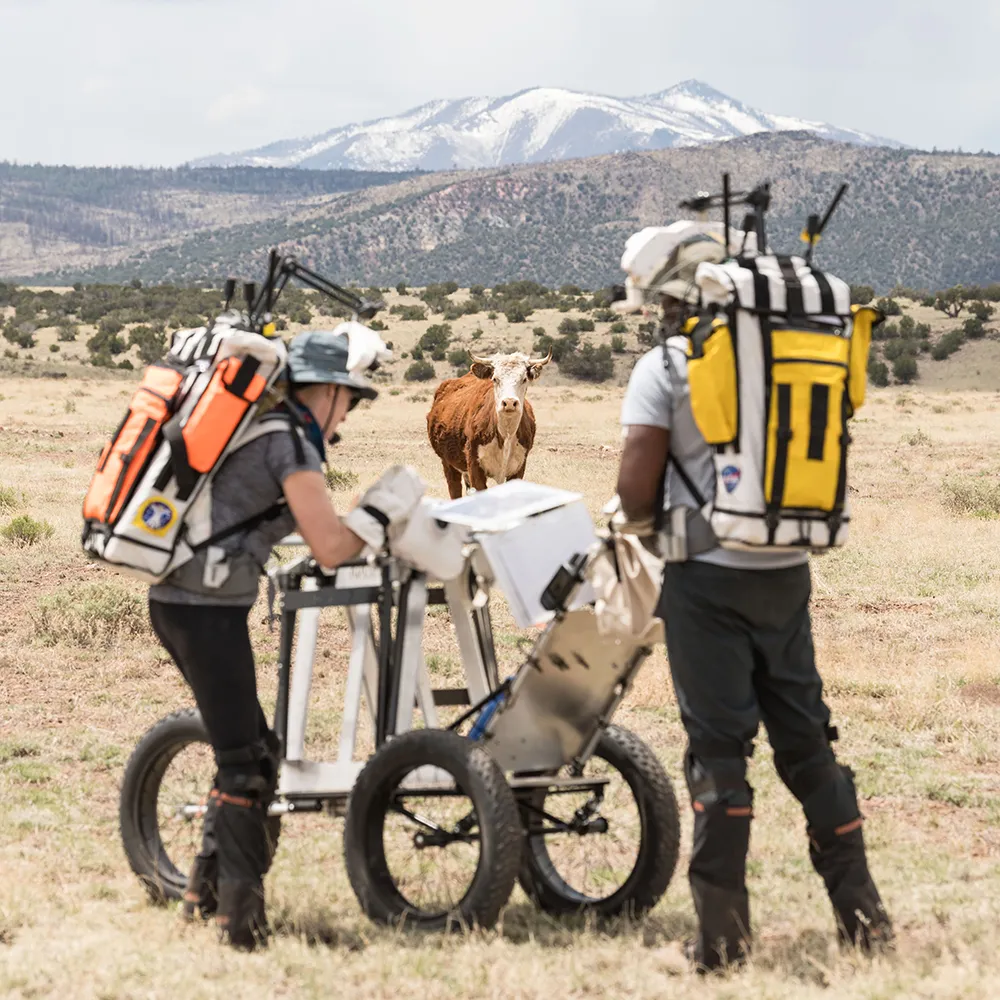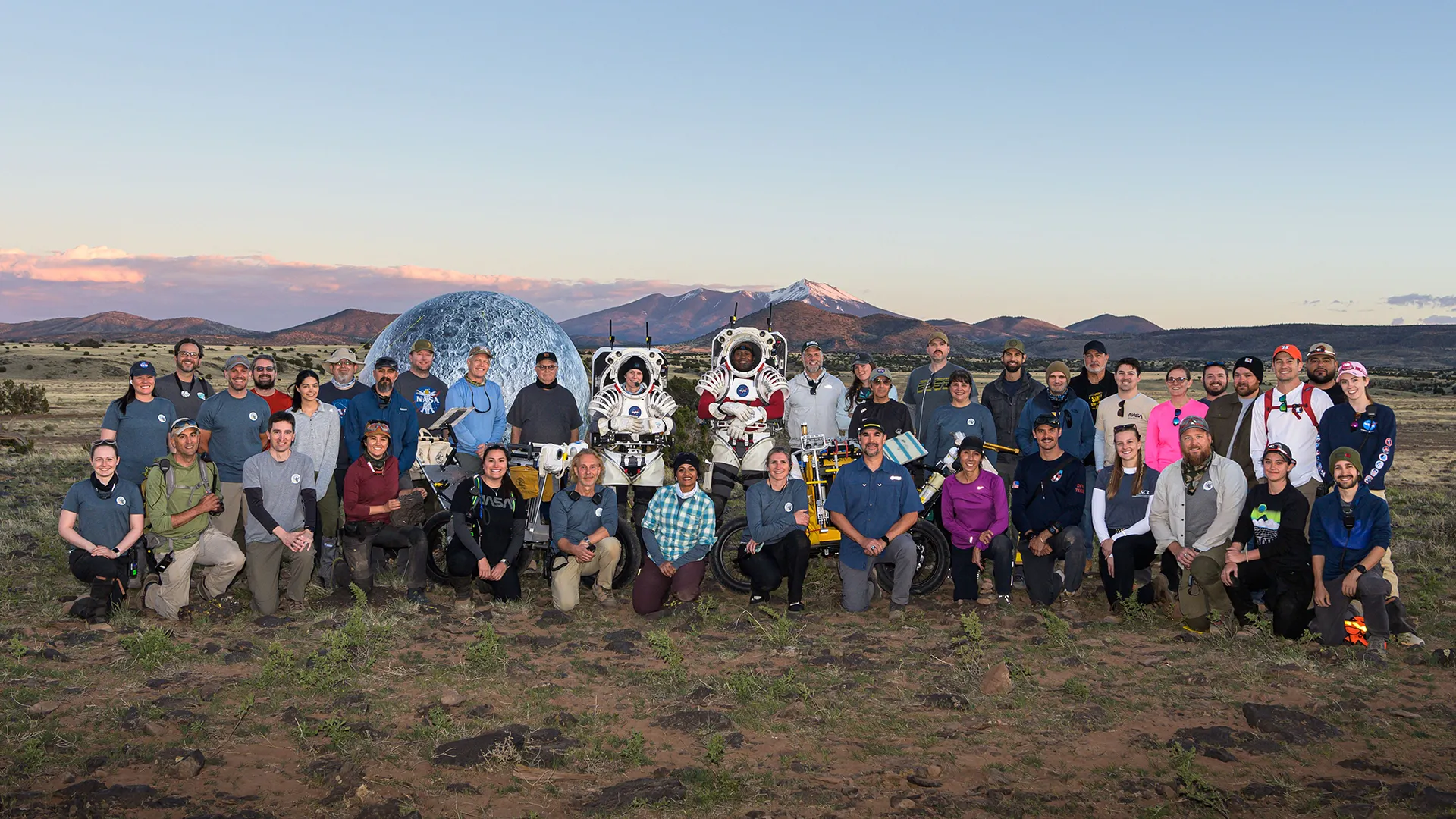- June 03, 2024
- By Karen Shih ’09
As the piercing low light casts extreme shadows before them, two astronauts trudge across the barren landscape, pushing science equipment to collect rock samples.
But when cows wander by and rattlesnakes slither through the brush, the illusion breaks: They’re not on another planet.
Instead, they’re in Arizona, where NASA is preparing for the first crewed mission to the moon in nearly 50 years when Artemis III takes off in 2026.

In mid-May, University of Maryland and NASA Goddard Space Flight Center Associate Research Scientist Patrick Whelley served as the field safety officer for the latest two-week test mission out at the San Francisco Volcanic Field about 25 miles north of Flagstaff. He oversaw a team of 10, including medical professionals, to ensure everything went smoothly for not only the astronauts but the broader crew of about 50.
“Going to the moon is difficult,” he said. “There are so many people working together toward this common goal. … There’s a lot of folks, like engineers and technicians, who don’t go out in the field a lot. My role is to make this experience comfortable and positive and productive for everyone.”
A geologist, Whelley has traveled the world, from Chile to Hawaii, seeking to understand how volcanoes on Earth can help explain their physics on rocky moons and planets. As the projects grew to 30 or 40 members, he had to develop safety and logistics plans, preparing for risks like hypothermia or dehydration, animal encounters with snakes or spiders, and specialized equipment for handling lava.
Then in 2018, the Joint Extra Vehicular Activity Test Team (JETT) team at NASA reached out to him to observe one of his trips to Iceland. Liking his approach, they invited him to join the Artemis tests.
[Alum Astronaut Reports From Space Station: ‘I’m Still in Awe’]
The May mission, JETT’s fifth so far, focused on communications between the astronauts in the field and mission controllers and scientists at NASA’s Johnson Space Center in Houston. The test crew conducted “moonwalks” during the day and at night, wearing different space suit iterations to test how their bulkiness and weight affects astronauts’ ability to perform experiments and collect rock samples, as well as how well they can use the suit-embedded tech to describe what they’re doing and seeing to the team in Texas. They’ll be in uncharted territory: Artemis III will land at the lunar South Pole, an area no humans have studied before.
“We’re trying to make sure that all parties understand what having people on the moon is going to be like with our modern infrastructure and modern expectations,” Whelley said. The goal is “to empower the science team in Houston to have real time, or as close to real time, information to better support the astronauts on the moon.”
Whelley’s role includes writing a safety plan, coordinating responses to emergencies and walking the planned astronaut paths to look for hazards such as steep terrain or wild and—very unlunarlike—farm animals, since they partner with a ranch to use its land. Weather was one of the biggest challenges. Out in the desert, storms can roll in quickly, so when there’s lightning or high winds, Whelley has to make the call to delay or take a rest day.
Working at night presented other challenges. To mimic the low angle of the sun at the moon’s South Pole, the JETT team brought a large light to simulate the unusual angle that the astronauts will have to cope with. The evening tests, which run from about 7 p.m. to 1 a.m., help the team understand how cameras may focus differently under different light, or how to adjust the paths that astronauts plan to traverse so they’re not walking directly into sunlight for a long distance.
He’s eager to help get humans back on the moon, said Whelley, especially after decades of scientific advancements since the last crewed lunar mission. A big question remains: Is there ice—and therefore water—on the moon?
“There's so many things we're going to learn about the solar system by getting samples with new techniques from new locations,” he said. “It’s really exciting.”

Topics
Research